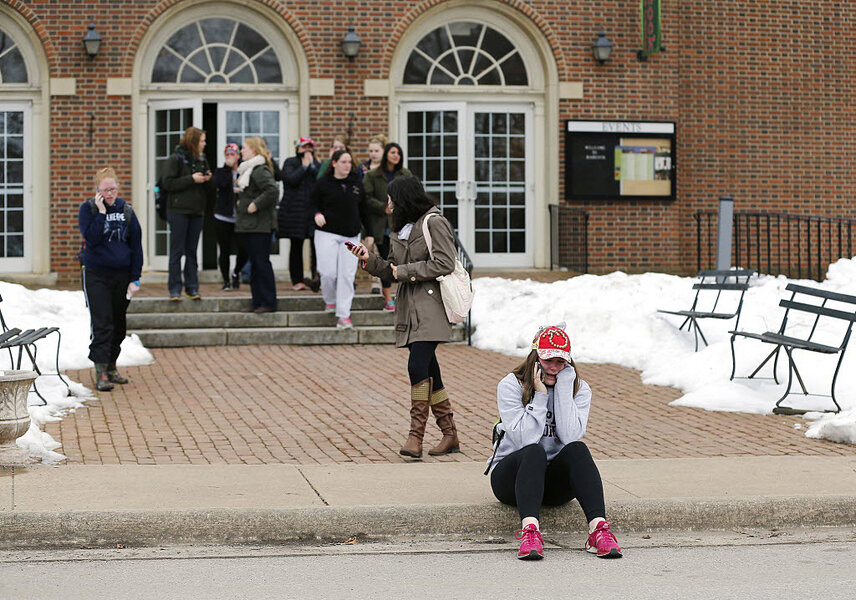Sweet Briar College to close: Are women's colleges still relevant?
Loading...
Students and alumni of Virginia's Sweet Briar College were shocked to learn Tuesday that the 114-year-old, all-women's school would close its doors at the end of August.
“I was absolutely devastated and shocked. It wasn’t anything that anyone suspected," says Diana Simpson, a constitutional litigator who graduated from Sweet Briar in 2008. "Heartbreak is the only word I could use to describe it.”
Students hugged and cried as they learned that their school’s financial difficulties were too much to overcome. Now Sweet Briar, an all-women, private school near Lynchburg, Va., will hold its final commencement in May and end all operations at the end of the summer session.
"Everybody is in a panic," Sweet Briar student Reba Gagne told a local CBS affiliate. "This is a very sudden thing. It comes as a shock to all of us."
Tuesday's announcement calls attention to the challenges facing women's institutions of higher education in the United States. As the ranks of women in the nation's coeducational institutions have swelled, some education experts suggest that the need for all-female schools has become less pressing.
“These institutions can no longer serve their original purpose: providing opportunities for those shut out from the male-dominated world of higher education.... As women continue to advance in society and as the detrimental effects of gender discrimination continue to fade, women’s colleges will continue to decline in number and in purpose,” wrote Brian Burton for the Harvard Political Review in 2010.
Fifty years ago there were 230 women’s colleges in the United States, The Washington Post reports. Today there are barely more than 40.
Some women’s colleges, such as Smith College, Wellesley College, Barnard College, Bryn Mawr College, and historically black Spelman College, have continued to flourish as hallmarks of women’s higher education. But many smaller, single-sex, liberal arts schools have faced financial difficulties and chosen to close, merge with other schools, or admit men as well as women.
In 1969, Vassar College in Poughkeepsie, N.Y., was one of the first schools to go co-ed due to a drop in enrollment. Randolph-Macon Woman’s College, in Lynchburg, Va., became coed in 2007 and changed its name to Randolph College. And in 2013, members of the board of trustees of Wilson College in Chambersburg, Pa., announced that they had voted to make the college coeducational in order to boost enrollment and improve the appeal and vibrancy of the school.
As a small, liberal arts college with enrollment hovering around 700 students, it is not unusual that Sweet Briar would face financial difficulties. Many small private colleges have been struggling financially in recent years. But Sweet Briar President James Jones Jr. cited a declining interest in single-sex education as one of the main reasons for the school’s imminent closure.
"The board, some key alumnae and I have worked diligently to find a solution to the challenges Sweet Briar faces," Dr. Jones said in a statement. "This work led us to the unfortunate conclusion that there are two key realities that we could not change: the declining number of students choosing to attend small, rural, private liberal arts colleges and even fewer young women willing to consider a single-sex education.”
Despite recruitment efforts, the school saw a roughly 8 percent drop in undergraduate enrollment between the 2009-2010 and 2014-2015 school years, according to data reported by Inside Higher Ed.
But some say that Sweet Briar’s fate does not ring a death knell for all women’s colleges.
“There are a lot of women’s colleges that are doing fine,” Marilyn Hammond, interim president of the Women’s College Coalition, told The Washington Post. “To say it’s a sector issue would not be correct.”
Ms. Hammond suggests that attempts to attract women from more diverse backgrounds, such as women of color or low-income women, could be a solution for struggling women’s colleges.
Meanwhile, supporters stress the importance of preserving the unique opportunity to attend all-women institutions.
“Attending a women’s college was one of the best choices I ever made. It is a unique experience that you cannot attain in a co-ed setting. The most important thing was the leadership skills that the school taught me. I was able to be in class and not focus on others or on men. I felt comfortable just going into a room and contributing. This is a skill I have found invaluable in a courtroom, especially as a young, female attorney,” says Sweet Briar alumna Ms. Simpson.
Sweet Briar officials have said they would help students transfer, possibly to other women’s schools in Virginia such as Hollins University or Mary Baldwin College.
To avoid Sweet Briar’s fate, Mary Baldwin College has expanded its focus, creating new colleges for education and health professions. School officials said the move would make the college financially sustainable, Inside Higher Ed reported. But some professors have expressed concern that the school’s liberal arts ideals will be compromised.
Regardless of the other single-sex education opportunities available, Sweet Briar students are reluctant to leave their school.
"I don't want to go anywhere else," student, Katherine Day said to a local CBS affiliate.
"Everything about this campus is perfect."







